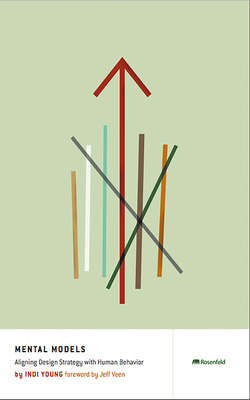Читать книгу Mental Models - Indi Young - Страница 11
На сайте Литреса книга снята с продажи.
Continuity of Strategy
ОглавлениеA mental model with features and solutions aligned beneath it becomes a roadmap for strategy over the next decade. After your initial brainstorm of how to support users, you will know that you can’t possibly implement every idea in the next three or four quarters. Things will get pushed off. New ideas will materialize as the market and technology changes. You will see new opportunities in three years that don’t exist today. The diagram persists as a visual map of where you plan to go.
Rely on Mental Models to Change Slowly
User mental models change slowly. Take the concept of cash. Coinage has been around for centuries upon centuries. People exchange coinage for services, goods, and materials, and they have developed ways to carry, obtain, and securely store cash. Then the ATM came along and changed how people obtain cash. It has not yet been fully adopted. Many still prefer the mental model of going to a bank and getting cash from a teller. Now plastic exchange of currency has become widely available. You can use a debit, credit, or pngt card in place of currency, which makes the act of carrying, obtaining, and securely storing cash largely unnecessary. But adoption of the plastic model was slow, thus the mental model regarding cash was slow to change. You can be reasonably sure that most mental models you make will likewise be valid for many years to come. Basing a continuous strategy on a long-lived artifact is a good idea.
Keep the Knowledge, Shift the Team Members
Also, it is a fact of life that the members of a particular team change over time. One of the more difficult problems organizations face is preservation of internal knowledge. Mental models guide your team’s progress over the years and become a place where decision history and rationale is recorded, as a foundation of decisions to come.
So if you’re thinking a mental model might help you with your work, you may be asking, “How does it fit into what I’m already doing?” The next chapter will answer this question.
[1] From the book Difficult Conversations by Douglas Stone, Bruce Patton, and Sheila Heen of the Harvard Negotiation Project, Chapter 9, “Empathy is a Journey, Not a Destination,” p. 183.
[2] Jay Morgan, Applied Cognitive Scientist, MS in Applied Cognition and Neuroscience, University of Texas at Dallas, 2004.
[3] “A Conversation with Michael Bierut,” http://www.tinyurl.com/pkruo
[4] Adaptive Path blog entry “Designing for Luck ,”http://www.tinyurl.com/2hh9oc
[5] Favorite mantra of Mary Piontkowski, researcher, information architect, interaction designer, and a frequent collaborator of mine, and contributor to mental-model process adaptations and improvements.
[6]House Beautiful, June 2006, “Giants of Design” awards article, page 120.
[7]Future of Web Design conference, London, UK, April 2007, http://www.futureofwebdesign.com/
[8] Jared Spool’s UI11 conference article “Innovation is the New Black,” http://www.tinyurl.com/olwgh
[9]BusinessWeek online article “Experience Is the Product” by Peter Merholz on June 22, 2007. http://www.tinyurl.com/2cqcbz
[10] “Experience IS the Product...and the only thing users care about” by Peter Merholz in June 2007 for the Industrial Design Supersite Core77, http://www.tinyurl.com/2dtrvb
[11] Brandon Schauer presented in “Connecting Design to Real Business Value” at Adaptive Path’s Managing Experience through Creative Leadership conference, in San Francisco, February 2007. Slides at http://www.tinyurl.com/3bg3c7. Brandon has a Master of Design degree from the Institute of Design in Chicago and an MBA from the Stuart School of Business. For more of Brandon’s writing, see his blog at http://www.brandonschauer.com/blog
[12]Harvard Business Review, “What is Strategy?” by Michael E. Porter, November 1996. http://www.tinyurl.com/ypqzfs
[13] Institute of Design, Strategy Conference Perspectives 2005, Issue 2, “Interview: The Emergence of New Innovation Disciplines,” Brandon Schauer interviews Larry Keeley. http://www.tinyurl.com/2ajpeb
[14] Jeff Veen of Google talks about designing from the user’s perspective during an interview with Josh Owens and Chris Saylor on the Web 2.0 Show, http://www.tinyurl.com/ywaonn. For more of Jeff’s writing, see http://www.veen.com/jeff/index.html.
